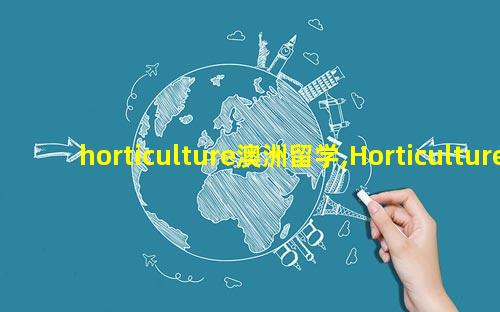 锦泰留学网
锦泰留学网Horticulture is the science and art of cultivating plants, specifically in gardens, orchards, and nurseries. It involves the study of plants, their growth, development, and management for various purposes such as food production, landscaping, and ornamental gardening.
Australia is a popular destination for studying horticulture due to its diverse climatic conditions, abundant natural beauty, and advanced agricultural industry. Australian universities and colleges offer various horticulture programs and degrees that cover different aspects of plant science and management.
Studying horticulture in Australia can provide students with valuable knowledge and skills in areas such as plant propagation, pest and disease management, landscape design, and sustainable farming practices. Students may also have the opportunity to gain hands-on experience through laboratory work, field trips, and internships.
Furthermore, Australia's horticulture industry offers promising career opportunities for graduates. With a focus on sustainable and environmentally friendly practices, there is a growing demand for skilled horticulturists in areas such as agricultural research, landscape architecture, gardening services, and food production.
Overall, studying horticulture in Australia can offer students a comprehensive education in plant science and management, as well as provide them with ample career opportunities in the thriving horticulture industry.
The "Horticulture Plant Journal" is a comprehensive publication that focuses on all aspects of horticultural plants. It covers a wide range of topics including plant propagation, cultivation, pest management, disease control, plant nutrition, and more. The journal provides updates on the latest research findings, innovative techniques, and best practices in the field of horticulture.
The "Horticulture Plant Journal" also features articles on specific plant species or groups, highlighting their characteristics, growing requirements, and potential applications in landscaping, gardening, and agriculture. In addition, it includes reviews of new plant varieties, equipment, and technologies that can enhance horticultural practices.
The journal aims to cater to the needs of horticulturists, plant researchers, growers, landscapers, gardeners, and anyone interested in learning more about horticultural plants. It serves as a valuable resource for professionals in the industry, providing them with the latest information and insights to improve their knowledge and skills.
Overall, the "Horticulture Plant Journal" acts as a platform for the exchange of ideas, knowledge, and experiences in the field of horticulture. It contributes to the advancement of the industry by promoting sustainable and efficient practices in the cultivation and management of horticultural plants.
Horticulture Research 是一个经过同行评审的开放获取的学术期刊,属于Springer Nature 出版集团旗下子刊。该期刊发表了与园艺和种植有关的研究论文、综述、观点和通讯。它的目标是促进对园艺研究的发展和交流。
Horticulture Research 的编辑团队由一群经验丰富的科学家组成,他们在园艺领域有广泛的知识和专业背景。期刊的审稿过程严谨,确保发表的论文具有高质量和科学价值。
该期刊的影响因子还比较低,但正逐渐增加。它还提供了在线快速出版的机会,使研究人员能够更快地传播他们的研究成果。
Horticulture Research 是一个权威的园艺研究期刊,提供了一个国际交流的平台,但在学术影响力方面还有进一步发展的空间。
Horticulture technology refers to the use of advanced tools, techniques, and knowledge in the field of horticulture, which is the science and art of cultivating plants. It involves the application of technology to optimize plant growth, improve crop yield and quality, and streamline the overall horticultural process.
Some examples of horticulture technology include:

1. Greenhouse technology: The use of advanced greenhouse structures equipped with environmental controls such as temperature, humidity, and light, to create optimal growing conditions for plants.
2. Irrigation systems: Utilizing automated irrigation systems that provide the right amount of water to plants at the right time, reducing water wastage, and optimizing water usage.

3. Precision agriculture: Implementing technology such as GPS, drones, and remote sensing to collect data about soil health, plant nutrition, and growth patterns, enabling farmers to make informed decisions about crop management.
4. Hydroponics: Growing plants in a soilless medium and providing all essential nutrients directly to the plant roots through a water-based nutrient solution. Hydroponics allows for precise control over plant nutrition and maximizes resource efficiency.
5. Crop protection: Utilizing integrated pest management (IPM) techniques, which involve the use of biological controls, pesticides, and other methods to minimize the impact of pests, diseases, and weeds on crops.
6. Plant breeding and genetics: Applying advanced techniques such as genetic modification, tissue culture, and molecular markers to develop new plant varieties with desirable traits, such as increased yield, disease resistance, or drought tolerance.
7. Post-harvest technology: Using technology to extend the shelf life of harvested crops, such as controlled atmosphere storage, temperature and humidity-controlled storage, and advanced packaging methods.
The integration of technology in horticulture helps to optimize productivity, reduce resource wastage, improve sustainability, and meet the increasing demand for high-quality, safe, and nutritious food.